IN THIS ISSUE
- Loggerheads' breakout year
- A champ for Georgia plants
- Rare bird rebound at Silver Lake
- Backyard pearls with wings
- You can't keep a good raptor down
 Mama loggerhead on Ossabaw Island (Caliegh Quick/DNR)
In April, Georgia Sea Turtle Program Coordinator Mark Dodd said he expected loggerhead sea turtle nesting to bounce back this year after a so-so 2018.
Nailed it.
As of Wednesday, there were more than 2,200 loggerhead nests on Georgia beaches. At halfway through the nesting season, the state’s primary nesting sea turtle has already surpassed last year’s season total of 1,735.
More stats: By the end of May, the count had topped 1,000. The previous high for May was 596 nests in 2016. And that year ended with a state-record 3,289 nests, according to the Georgia Sea Turtle Cooperative, a network of volunteers, scientists and organizations that daily monitors and protects sea turtle nests.
"Overall, we expect approximately 4,400 nests on Georgia beaches," Dodd wrote. "That's an exciting number and over 1,000 nests more than our previous record."
Daily nesting updates | Instagram story | See turtles, protect turtles
Video: loggerhead on Ossabaw
WHAT YOU CAN DO
All marine turtles in Georgia are protected by law. To help conserve them:
- When on the beach at night, don’t use flashlights and flash photography. They can deter turtles from coming ashore to nest or cause them to abort nesting.
- If you encounter a sea turtle on the beach, remain quiet, still and at a distance.
- When boating, stay alert and avoid turtles. If you hit one, stand-by and immediately call DNR at 800-2-SAVE-ME (800-272-8363).
- Report any dead or injured sea turtles seen at 800-272-8363.
- Renew or buy a DNR eagle or hummingbird license plate – only $25 more than a standard plate and most of the fee goes to conserve wildlife.
- Donate online to the Georgia Wildlife Conservation Fund, dedicated by law to conserving the state’s rare and other native animals that aren’t legally hunted, fished for or trapped, and rare plants and natural habitats.
Top
 Tom Patrick, left, with his wife Bretta; right, receiving the GPCA award (Pandra Williams/Beech Hollow Farm)
Botanist Tom Patrick has been turning attention to Georgia's rare plants and working to conserve them for decades.
His favored word for such finds in the field? “Goodies.”
Last month, the Georgia Plant Conservation Alliance turned the attention on the DNR veteran, creating an award named in his honor and handing the first one to him. Patrick is, according to the presentation, “a person who has embodied the mission and vision of GPCA since (its) earliest days.” In a word, a goody.
Patrick has studied plants since the 1960s. In 1986, he became the Georgia Natural Heritage Inventory Program’s first botanist, a program later folded into what is now the DNR Wildlife Conservation Section. His specialty is trilliums. Yet his scope is broad, ranging from protecting mountain bogs (he is considered one of the state’s “bogfathers”) to restoring chalk prairies in middle Georgia and discovering new sites for rare plants, such as silver buckthorn along the lower Savannah River.
He also was key to starting the GPCA in 1995. In presenting the award to its surprised namesake during the conservation network’s meeting at Beech Hollow Farm, State Botanical Garden Director Dr. Jenny Cruse-Sanders said Patrick has dedicated his professional life to “conserving the threatened plants and natural communities of our state” and sharing his knowledge with others.
“Those of us in this room have spent thousands of hours with Tom in the field, during which he has patiently answered tens of thousands of questions and pointed out an endless number of natural wonders, large and small,” Cruse-Sanders said.
Patrick is still helping keep GPCA "on the right path,” she added.
The Tom Patrick Award is the organization's highest honor. It will be awarded on special occasions to recognize outstanding achievement in plant conservation.
Top
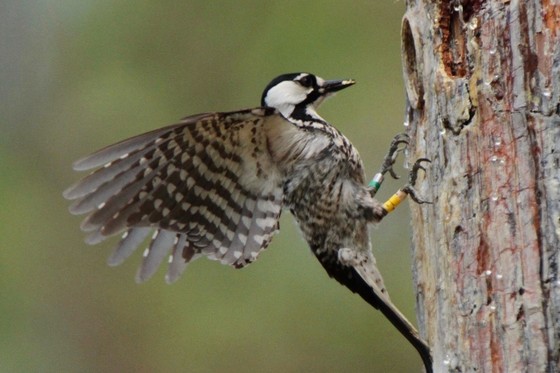 Red-cockaded woodpecker bringing food to a nest at Silver Lake (Josiah Lavender/DNR)
Red-cockaded woodpeckers are keeping Joe Burnam busy at Silver Lake Wildlife Management Area.
Burnam, DNR’s lead biologist for the endangered birds, is scoping nests, banding chicks and helping sort out how best to manage the nearly 40 clusters of nest trees on the WMA near Bainbridge.
But the work is welcomed eight months after Hurricane Michael scrambled southwest Georgia’s landscape. The acres of mangled and downed trees included more than half of the 272 pines on Silver Lake with red-cockaded woodpecker nest cavities. Without these nest and roost sites, the birds didn’t stand a chance.
Soon after the storm, DNR and partners began clearing access to clusters, installing more than 100 nest inserts and clearing debris from the base of nest trees. The effort, profiled in this video and supported by an emergency grant from the National Fish and Wildlife Foundation, not only added nest cavities and removed debris, it allowed staff to apply prescribed fire in many areas. The controlled burns consumed limbs and litter and boosted the diverse groundcover the woodpeckers and scores of other species such as quail and turkeys thrive on.
The restoration continues. About 30 more inserts will be added by fall, Burnam said. The debris work around nest sites “is freeing us up to get fire on the ground and reduce the likelihood we’re going to lose any more (nest) trees, which is important given the effects of the storm.”
Challenges still loom, such as dealing with the remaining downed timber. There is also concern even more trees will die, late casualties of stress from the hurricane.
Yet Silver Lake’s recovery has a silver lining: Red-cockaded woodpeckers are rebounding. Burnam is monitoring 25 nests and nearly 40 young this spring.
The number of breeding groups – woodpeckers nesting in a cluster of cavity trees – is down at the WMA, 28 compared to 32 before Michael. “But I’m optimistic we’ll get back to the pre-storm numbers within the next few years,” Burnam said.
AN OPENING FOR LONGLEAF
Hurricane Michael also destroyed swaths of pines on 29,000-acre Tyndall Air Force Base in the Florida Panhandle. However, the damage may actually speed up plans by the Air Force and the U.S. Fish and Wildlife Service to plant longleaf pines. Read on.
Top
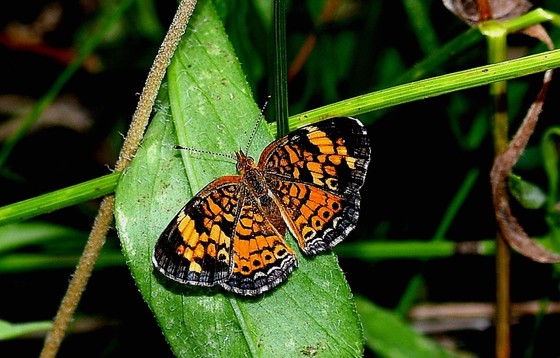 An eye-catching pearl crescent (Terry W. Johnson)
By TERRY W. JOHNSON
The pearl crescent is one of the most beautiful butterflies to grace Georgia. Yet, while one of the most common butterflies, because of its demure size it is also one of our most overlooked.
The pearl crescent has a wingspan of no more than 1.75 inches. Looking down on one, the butterfly is tawny orange and black, with wings bordered in black and marked with black on orange splotches.
But underneath is where you’ll discover the reason for its name. Along the trailing edge of the hind underwing is a dark patch encircling a pale crescent. …
Read the rest of Terry’s column to learn about these tiny beauties.
Terry W. Johnson is a retired DNR program manager and executive director of TERN, the Wildlife Conservation Section’s friends group. Find more columns, Terry’s Backyard Wildlife Connection blog and his book “A Journey of Discovery: Monroe County Outdoors.” (Permission is required to reprint this column.)
CONGRATULATIONS FROM THE CLUB
 Terry Johnson with The Garden Club's Jane Hersey (left) and Diane Harbin (The Garden Club of Georgia)
Although he doesn’t enjoy the spotlight, Terry W. Johnson was in it this spring when he received The Garden Club of Georgia’s highest award for a non-member. Then-club President Jane Hersey presented the Award of Merit to Johnson for his work in helping start and continuing to lead the Community Wildlife Program. The 20-year-old Garden Club/DNR program is focused on enhancing native wildlife and habitats statewide through the club’s some 9,000 members.
Top
 Bald eagle in flight (Tom Wilson/Georgia Nature Photographers Association)
Although bald eagles in southwest Georgia took it on the beak from a fall hurricane and heavy winter rains, the big picture for nesting this season is upbeat: Eagles are still going strong in the state.
DNR helicopter surveys of coastal counties and a western chunk of Georgia framed by interstates 20 and 75 and the Alabama and Florida state lines counted 168 nests (including a few monitored outside those areas) and an estimated 195 young fledged.
Survey leader Dr. Bob Sargent said that considering the number of nests he usually finds in north Georgia during every-other-year surveys of that region, it’s likely the state had more than 200 eagle nests for the fifth straight year.
That’s good news for America’s bird and even better news for Georgia, which had no known nests in the 1970s.
The bad: Hurricane Michael destroyed 14 nests or nest trees in southwest Georgia in October. Also, excessive rain that fall through winter likely disrupted mating and nesting by raising water levels and reducing the eagles’ ability to find fish to eat. The rain might also have undercut hatching rates and the survival of eaglets.
Read more.
 A bald eagle nest (circled area) in a southwest Georgia forest ravaged by Michael (Bob Sargent/DNR)
SURVEY INSIGHTS
-
2019 stats: 168 occupied nest territories, with 127 fledging at least one eaglet (76 percent success rate, which is average) and 195 young fledged (1.2 per occupied territory; also average).
-
Michael destroyed 14 nest trees or nests in Seminole and Decatur counties. In 12 of the 14 cases, 60-70 percent of trees in the surrounding forest were leveled. Because of the lack of suitable nest trees, it’s likely many eagle pairs that nested in the region before did not nest there this year.
-
In March, only two coastal nests checked had an eagle still incubating eggs. Yet in southwest Georgia, eggs were being incubated at 12 nests. Why? Habitat damage from Michael and heavy rainfall October-January likely delayed mating and nesting, reduced eagle fishing success rates, and possibly increased the mortality of egg embryos (and nestlings), leaving some eagles incubating non-viable eggs a week or more after they should have hatched.
WHAT YOU CAN DO
Report eagle nests online or by phone (478-994-1438) or email. (PS: Osprey nests are sometimes confused with eagles’. Check out the differences in these profiles of bald eagles and ospreys.)
Top
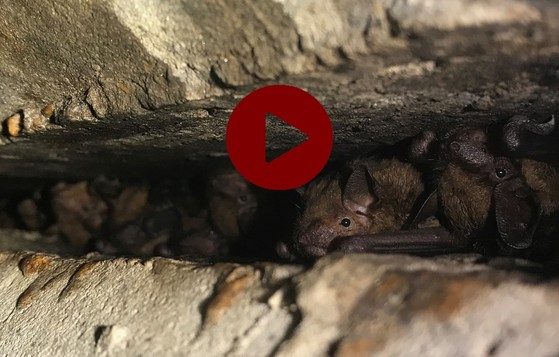 Bats under bridge (DNR)
White-nose syndrome is still plaguing bats in Georgia, but DNR survey results this winter and the last show that bat counts – while low – appear relatively stable. Learn more in the updated report “Tracking a Killer: WNS in Georgia.”
Chattahoochee Fall Line Wildlife Management Area in west Georgia is bigger and better after adding the Hilliard Plantation Tract. The 8,092-acre expansion includes five habitats rated conservation priorities in Georgia’s State Wildlife Action Plan, rich potential for ecological restoration and outdoor recreation.
High water washed out DNR plans to tag spawning robust redhorse on the Savannah River last month. Undeterred, the agency and partners periodically conduct samplings to find fish tagged in 2018, and plan to try tagging again in 2020.
Top
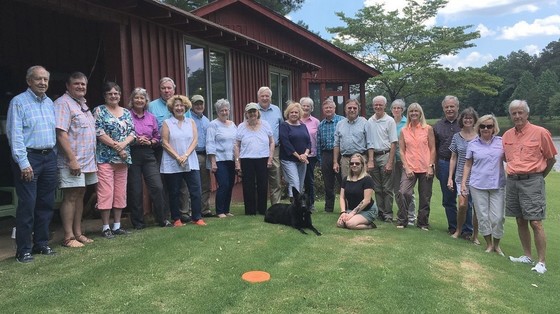 TERN members attending the annual meeting (TERN)
The Environmental Resources Network, better known as TERN, approved funding nearly $43,000 in wildlife conservation and education projects at the group’s annual meeting in Forsyth this month. Since 1992, the friends group of DNR's Wildlife Conservation Section has provided more than $1.4 million in grants supporting everything from research to wildlife camps and equipment needed for sea turtle studies and prescribed fires. Become a member.
The Georgia Department of Transportation will alter mowing along two powerline rights-of-way in Charlton and Ware counties to avoid key habitats and plants. The management decision, which followed a meeting between DOT, DNR and Okefenokee Swamp Park staff, will spare night-blooming wild petunia and hooded and parrot pitcherplants in wet flatwoods and bogs under the powerlines.
New signs at Guild’s Inlet and three other key spots on St. Simons’ beaches explain how visitors can protect sea turtles and shorebirds. Project leader One Hundred Miles is also providing posters and table tents with similar messaging to local businesses, work partially funded by a DNR wildlife viewing grant.
Two new billboards on Interstate 95 encourage travelers to report invasive species using the Early Detection Distribution Mapping System, or EDDMapS. Jekyll Island Authority developed the billboard graphics for the DNR awareness campaign, which was backed by a National Fish and Wildlife Foundation grant.
Top
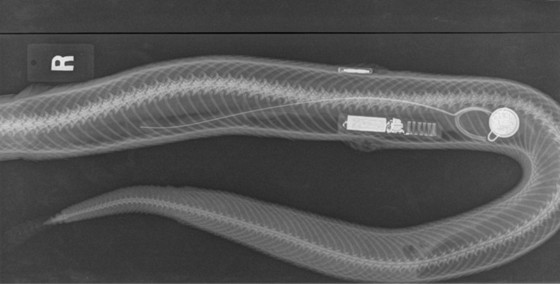 Rattler x-ray shows quail collar (coin-like), snake tag (long object) and PIT tag (small, in skin)
Swallowing a radio-collared quail led to a timber rattler receiving its own radio tag. Researchers tracked a mortality signal from the quail collar to the rattlesnake, which was then tagged as part of a UGA grad student’s study of how supplemental feeding affects movement and use of space by timber rattlers, black ratsnakes and northern bobwhites. (Hammond Hills Animal Hospital radiographed the snake out of concern it would not pass the quail collar. It did, and has been released.)
Georgia’s 2019-2020 hunting seasons are online. Also just out: dove season details, including changes that push the close of dove hunting to Jan. 31, 2020.
Two tips on living around black bears: Never leave pet food outdoors (only give outdoor pets portions that will be completely eaten at one feeding) and clean and store your grills in an area secure from bears. More at BearWise.org.
Frustrated by flightless geese? Here’s advice for coping with molting Canada geese, including a time-proven approach – patience.
Top
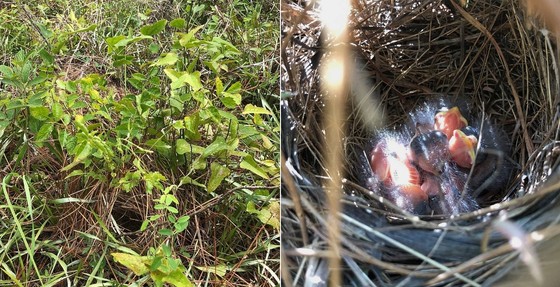 Bachman's sparrow nest and young (Bronc Rice)
Bachman’s sparrow is a high-priority species for conservation in Georgia’s State Wildlife Action Plan, and spotting this secretive bird’s nests is a treat. Bronc Rice reported the Bachman’s nest above, crowded with four young, in Mitchell County.
I spy … milkweeds! Anyone who spots milkweed along a Georgia roadway is encouraged to email the location to the state transportation department, which will help the agency with a new mowing program designed to support pollinator plants.
Charlie Elliott Wildlife Center’s summer camps and programs are in full swing. Recent outreach at the center near Mansfield featured Charlie’s Trackers, an outdoors day camp for 7- and 8-year-olds, and a Night of Froggery, in which participants learned about frog calls and ID, then visited ponds to find them.
A recent Nature Conservancy workshop demonstrated the potential of using drones to ignite prescribed fires. Led by Nature Conservancy fire management officer Erick Brown and including DNR and others, the demo included burning about 80 acres in two units in less than three hours.
Top
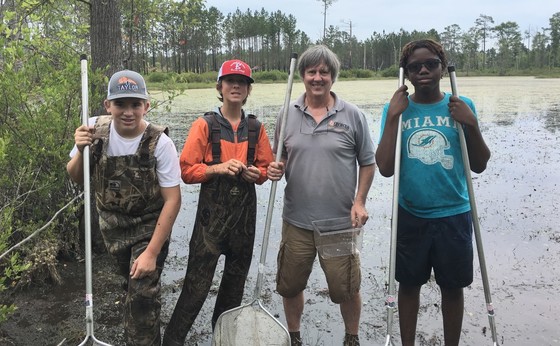 Taylor County 4-H students with DNR's John Jensen, second from right (Sherry Waller/4-H)
Names in the news: DNR senior wildlife biologist John Jensen led a Taylor County 4-H group to Sandhills Wildlife Management Area in Taylor County, where students and adults scoped gopher tortoise burrows and dip-netted ponds for frogs, tadpoles and salamanders to learn about sandhill and isolated wetland ecosystems. About 100 miles east, agency botanist Dr. Mincy Moffett Jr. walked Dr. Melissa Caspary’s biology class from Gwinnett Georgia College through a field lab exploring plant ecology and conservation at Ohoopee Dunes Wildlife Management Area near Swainsboro. Catherine Magee is the new state biologist for the USDA Natural Resources and Conservation Service in Athens. The DNR Wildlife Resources Division has promoted Brad Alexander from biologist to manager of its Private Lands Program. Alexander has worked for the program since 2013, first in south Georgia and most recently in Clarkesville.
UPCOMING
July 13 – Reptile Day, 10 a.m., Fernbank, Atlanta
July 16-17 – Georgia DNR grants workshop for 2019-2020 Georgia Outdoor Stewardship and Georgia Recreational Trails program grants, Amicalola Falls State Park, Dawsonville. Other workshops: July 23-24, Indian Springs State Park, Flovilla; July 30-31, Ft. McAllister State Park, Richmond Hill; Aug. 1-2, Little Ocmulgee State Park, McRae. Registration required.
Aug. 10 – Lessons from a Black Bear: Myths and Relationships, 11 a.m., Brasstown Bald
WHAT YOU MISSED …
In the previous Georgia Wild:
- Amazing bees
- Diamondback terrapin survey
- A season in the sandhills
- Answers about black fox squirrels
Top
"Sea turtle nesting off to record start," Savannah Morning News, and others via AP. Related: "Once threatened, sea turtle nests thrive along Georgia coast," The New York Times.
"Georgia blazes old fears, leads nation in prescribed fire," Southerly and The (Macon) Telegraph. Related: "Should California burn its forests to protect against catastrophe?" The Sacramento (Calif.) Bee
"Know the six (venomous) snake species in Georgia," WMGT-TV (Ch. 41, Macon)
"How to live with bears in your backyard," WAGA-TV (Ch. 5, Atlanta)
"Seeps and springs and pitcher plants," U.S. Fish and Wildlife Service
"Anglers, lawmakers champion Georgia's 'shoalie,'" Valdosta Daily Times
"Birding for people who do not like lists," Cool Green Science
"Slaughter of wolves paved way for (coyotes)," The Washington Post
"Ladybug swarm shows up on Weather Service radar," Los Angeles Times
"Beloved on Instagram, succulents vanishing from state parks," The Washington Post
"On the trail of tupelo honey," The New York Times
"More than 1 million ticks make up cringe-worthy collection in Georgia," Smithsonian
VIDEO AND AUDIO
 Argentine black and white tegu in Toombs County (Georgia Farm Monitor)
"Ranger Nick introduces a strange creature (invasive tegus in Toombs, Tattnall counties)," Georgia Farm Monitor
(audio) "To control wildfires, western officials urged to follow South's lead," National Public Radio. Related: "How the South fights fire with fire," Georgia Public Broadcasting
"Georgia's venomous snakes," DNR
"Summerville Hatchery lake sturgeon," DNR
"Second osprey fledges from Savannah nest," Landings Bird Cam
"How a species' extinction affected whiskey production," The History Guy
"Meeting a wormlion is the pits," PBS
Top
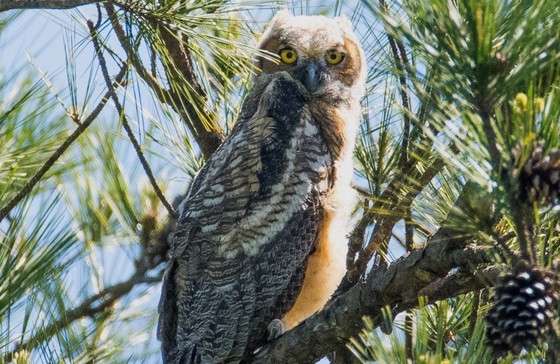 Young great horned owl (Ron Goldfarb)
Q. Ron Goldfarb asked what species of owl the young ones he photographed in his backyard in April were (above).
A. Fledgling great horned owls, replied Dr. Bob Sargent, a Wildlife Conservation Section program manager. And while their bodies are fully grown, the feather tufts on their heads -- often mistakenly called ears -- are still catching up, Sargent said.
Q. This questions has been in the news: How much of a rabies threat do bats pose?
A. Senior wildlife biologist Katrina Morris said that bats, like most mammals, can contract the rabies virus but the vast majority don’t. It is very unlikely anyone will come in contact with a rabid bat. With proper awareness and information, the presence of bats and other mammals does not pose public heath conflicts.
However, Morris said a bat that can be easily approached by humans is much more likely than others to be sick, and may bite if handled. Avoid touching bats or other wild animals. Learn more about bats and rabies.
Georgia is home to 16 species of bats. They are a fascinating part of our natural heritage, helping people by foraging on flying insects, many of which are pests.
Q. Trailing last month’s take on black fox squirrels came a question from Franklin Griffis about white ones. He has seen only one solid white fox squirrel in his lifetime in Wayne County – “you could see it flash in the sunlight … a beautiful animal” – and wondered how prevalent they were in other areas.
A. While our biologists couldn't speak to how common white fox squirrels are, any would be either leucistic or albino, and, as Griffis noted, less likely to survive long because of their lack of camouflage. It’s worth pointing out, too, that there are well-known populations of white gray squirrels, including in Brevard, N.C.
Got a Georgia wildlife question? Send it our way.
Top
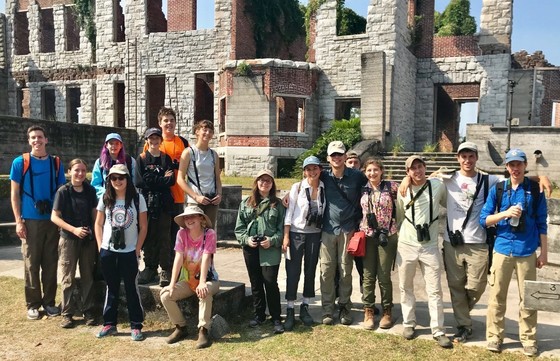 Camp TALON crew at Cumberland's Dungeness ruins (Bob Sargent/DNR)
Camp TALON teens take a break at Dungeness ruins on Cumberland Island, one of four islands the group explored along with other birding hotspots such as Fort Stewart, Okefenokee National Wildlife Refuge and Altamaha Wildlife Management Area. Held this month, DNR's 10th annual TALON – Teen Adventures Learning Ornithology and Nature – featured daytrips in the field capped with evening presentations and quizzes. Highlights ranged from roseate spoonbills and nesting American oystercatchers to a surprise blackburnian warbler on Little St. Simons Island, a June rarity on the Georgia coast. Sponsored by The Environmental Resources Network, Georgia Ornithological Society and Atlanta Audubon Society, TALON is led by Wildlife Conservation Section program manager Dr. Bob Sargent and educator Julie Duncan and features guest scientists and teachers.
CREDITS
Masthead: soaring bald eagle (Tom Wilson/Georgia Nature Photographers Association)
Top
|